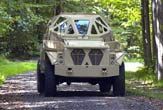Military: New Aluminum Windows Stop .50-Caliber Bullet

A new type of transparent armor made of aluminum could one day replace glass in military vehicles.
The product is called aluminum oxynitride. It is being tested by the Army and the University of Dayton Research Institute in Ohio.
The material is a ceramic compound with a high compressive strength and durability, according to an Army statement issued this week. It performs better than the multilayered glass products currently in use, and its about half the weight. It is virtually scratch-resistant.
"The substance itself is light-years ahead of glass," said 1st Lt. Joseph La Monica, who heads the research.
Glass is still used in the new process, being sandwhiched between an outer layer of the polished aluminum oxynitride and a polymer backing.
.50-caliber test
In a test this summer, the product held up to a .50-caliber sniper's rifle with amor-piercing bullets. Traditional glass armor did not survive the test.
Sign up for the Live Science daily newsletter now
Get the world’s most fascinating discoveries delivered straight to your inbox.
Officials hope the product will prove even more useful when considering more severe threats, such as explosives.
"The higher the threat, the more savings you're going to get," La Monica said. "With glass, to get the protection against higher threats, you have to keep building layers upon layers. But with [the new product], the material only needs to be increased a few millimeters."
"Achieving protection at lighter weights will allow the armor to be more easily integrated into vehicles," said Ron Hoffman, a researcher at University of Dayton Research Institute.
Cost vs. Durability
Time, blowing sand and other environmental factors degrade glass surfaces. The aluminum material is expected to retain its clarity for much longer.
"It all comes down to survivability and being able to see what's out there and to make decisions while having the added protection," Hoffman said.
The military is considering installing the aluminum windows on Humvees and low-flying, slower aircraft like the the C-130 Hercules.
The holdup for now is price.
Traditional transparent armor costs less than $4 per square inch. The aluminum oxynitride is now at least $10 per square inch. That price would come down with mass production. And the material's longevity would make it cost less than the initial price tag would indicate.
"It might cost more in the beginning, but it is going to cost less in the long run because you are going to have to replace it less," La Monica said.

Large Hadron Collider finds 1st evidence of the heaviest antimatter particle yet

James Webb telescope uncovers massive 'grand design' spiral galaxy in the early universe — and scientists can't explain how it got so big, so fast

'Alien plant' fossil discovered near Utah ghost town doesn't belong to any known plant families, living or extinct
Most Popular

